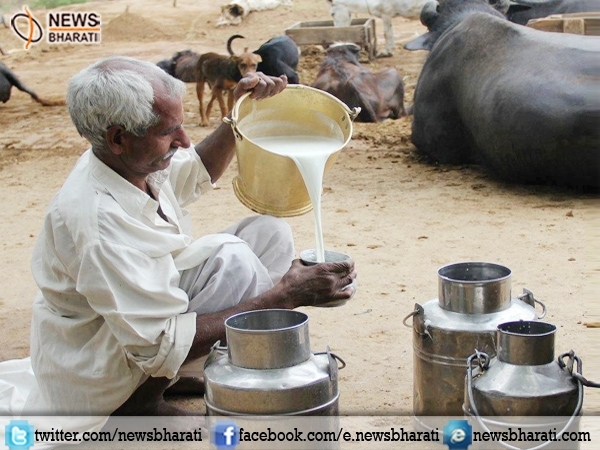Acche Din! Farmer’s income increased by 23.77% in last three years on milk production
New Delhi, January 21: India continues to be the largest milk producer in the world since two decades. Notably, milk production which was around 17-22 million tonnes in the 1960s, increased to 165.4 million tonnes during 2016-17. Particularly, it has increased by 20.12% during 2016-17 in comparison to 2013-14 while the income of farmers increased by 23.77% during 2014-17 as compared to 2011-14.

Agriculture Minister Radha Mohan Singh lauding the initiatives taken by government and implementation of various schemes said that the milk production is increased by 20.12% during 2016-17 in comparison to 2013-14. “Similarly, per capita availability has also increased from 307 grams in 2013-14 to 355 grams in 2016-17, registering 15.6% growth,” he added.
Agriculture Minister Radha Mohan Singh while addressing a farmers’ conference on Saturday said that the income of milk producers increased by 23.77% during 2014-17 as compared to 2011-14. “In the last 3 years, with the annual growth rate of 6.3%, India has outpaced global milk production where it has grown by 2.1%,” he added.
The Agriculture Minister also said that the Department of Animal Husbandry, Dairying and Fisheries has initiated a number of schemes with the objective of doubling the dairy farmers’ income by 2022. The Minister said that factors such as increased consumer interest in high protein diets and increasing awareness and availability of value-added dairy products through organized retail chains are also driving its demand.
“During the last 15 years, Milk Cooperatives have converted about 20% of milk procured into traditional and value-added products that offer about 20% higher revenue,” said Minister adding, “This share of value-added products is estimated to increase to 30% by 2021-22.”
He said that for the first time our government started a new initiative called Rashtriya Gokul Mission in December 2014 for the conservation and development of indigenous breeds. “Under this scheme, so far proposals worth Rs.1,348 crore from 28 states have been approved and Rs.503 crore has been released,” the Minister added.
Referring to the initiatives including Rashritya Gokul Mission Minister Radha Mohan Singh said that these Gokul Grams will act as Centres for development of indigenous breeds and a dependable source for supply of high genetic breeding. Currently, 18 Gokul Grams are being set up in 12 different states.
He further added that for the conservation of indigenous breeds two National Kamdhenu Breeding Centres in, one in Chintaladevi, Nellore in the Southern region and one in Itarsi, Hoshangabad in the Northern region of India are being set up. In these centres, 41 cattle and 13 buffalo breeds would be conserved. The Breeding Centre in Andhra Pradesh is ready.
The Minister, in the end, said that under Rashtriya Gokul Mission, a Rs. 825 crore National Bovine Productivity Mission was initiated in November 2016 with an objective to make the dairy business profitable by increasing the milk production and productivity. Similarly, for the first time, an e-Pashuhaat portal was created under National Bovine Productivity Mission, which plays an important role in linking milk producers with breeders.
He also stated that the World Bank funded National Dairy Plan Phase I is being implemented by NDDB in coordination with the respective state governments and Cooperative Institutions/State Dairy Federations. Under this scheme, 29 sub-projects for Bihar with a total grant of Rs.64.46 crore have been approved and Rs.37.04 crore was released until December 2017. These sub-projects have been targeted to benefit 1,50,000 dairy farmers in 2,928 villages.